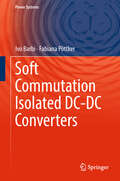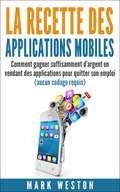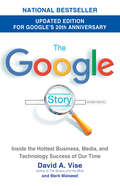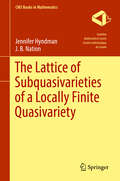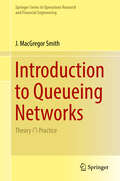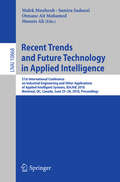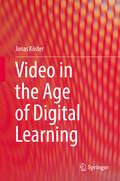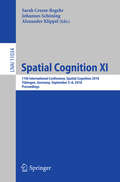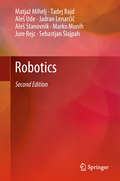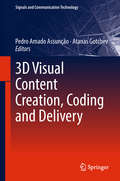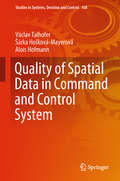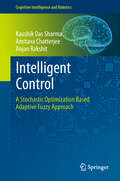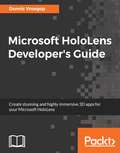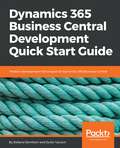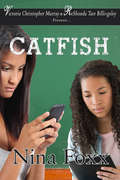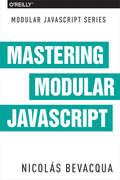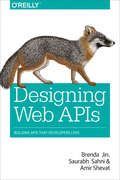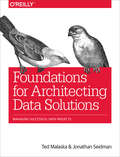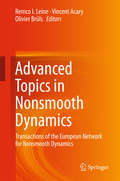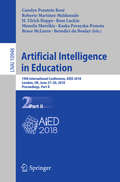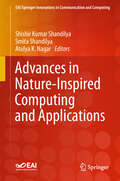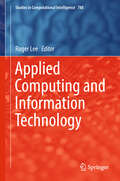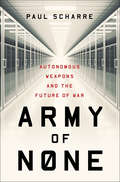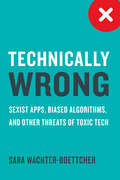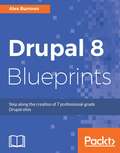- Table View
- List View
Soft Commutation Isolated DC-DC Converters (Power Systems)
by Ivo Barbi Fabiana PöttkerThis book describes the operation and analysis of soft-commutated isolated DC–DC converters used in the design of high efficiency and high power density equipment. It explains the basic principles behind first- and second-order circuits with power switches to enable readers to understand the importance of these converters in high efficiency and high power density power supply design for residential, commercial, industrial and medical use as well as in aerospace equipment.With each chapter featuring a different power converter topology, the book covers the most important resonant converters, including series resonant converters; resonant LLC converters; soft commutation pulse width modulation converters; zero voltage switching; and zero current switching. Each topic is presented with full analysis, a showcase of the power stages of the converters, exercises and their solutions as well as simulation results, which mainly focus on the commutation analysis and output characteristic.This book is a valuable source of information for professionals working in power electronics, power conversion and design of high efficiency and high power density DC–DC converters and switch mode power supplies. The book also serves as a point of reference for engineers responsible for development projects and equipment in companies and research centers and a text for advanced students.
La recette des applications mobiles
by Mark Weston Caroline PageauLa révolution des applications mobiles est en cours, alors pourquoi ne pas vous y joindre en téléchargeant votre exemplaire de La recette des applications mobiles dès maintenant! Avez-vous déjà envisagé faire de l’argent en lançant votre propre application? Saviez-vous que c’est facile, peu coûteux et à la portée de n’importe qui? Depuis l’arrivée du iPhone sur le marché en 2007, les applications mobiles sont rapidement devenues le Klondike du monde de la technologie. Si l’on considère les sommes investies pour l’achat de téléphones cellulaires et d’applications mobiles, il n’est pas étonnant que cette industrie produise des millionnaires chaque jour. Je ne suis pas ici pour vous dire que vous ferez fortune en téléversant une application, mais bien pour vous offrir une façon de développer progressivement une source de revenus passive. Dans mon livre, La recette des applications mobiles, je vous montre ce que vous devez faire pour commencer à développer un portefolio d’applications mobiles qui rapporteront jour après jour. Vous avez certainement déjà entendu parler de Angry Birdsou de Plants vs. Zombies? Ce sont des applications mobiles de jeux qui sont devenues des succès commerciaux. Mais nul besoin de créer de tels succès pour tirer un revenu d’une application mobile. Même l’application la plus élémentaire a le potentiel de générer un revenu simplement en raison du nombre de gens qui possèdent un téléphone cellulaire et téléchargent des applications. Dans ce livre, je vous enseigne comment vous pouvez commencer à développer une entreprise d’applications florissante, en profitant du levier extraordinaire que constitue Internet pour lancer une entreprise rapidement et à peu de frais. Vous n’avez même pas besoin de connaissances en codage! En fait, je conseillerais même de vous abstenir de tout codage, à moins d’avoir une idée de génie à laquelle vous tenez mor
The Google Story: Inside the Hottest Business, Media, and Technology Success of Our Time
by David A. Vise Mark MalseedThe definitive, bestselling account of the company that changed the way we work and live.Moscow-born Sergey Brin and Midwest-born Larry Page dropped out of graduate school at Stanford University to, as they said, “change the world” through a powerful search engine that would organize every bit of information on the Web for free. The Google Story takes you deep inside the company’s wild ride from an idea that struggled for funding in 1998 to a firm that today rakes in billions in profits. Based on scrupulous research and extraordinary access to Google, this fast-moving narrative reveals how an unorthodox management style and a culture of innovation enabled a search-engine giant to shake up Madison Avenue, clash with governments that accuse it of being a monopoly, deploy self-driving cars to forever change how we travel, and launch high-flying Internet balloons. Unafraid of controversy, Google is surging ahead with artificial intelligence that could cure diseases but also displace millions of people from their jobs, testing the founders’ guiding mantra: DON’T BE EVIL.Praise for The Google Story“[The authors] do a fine job of recounting Google’s rapid rise and explaining its search business.”—The New York Times“An intriguing insider view of the Google culture.”—Harvard Business Review“An interesting read on a powerhouse company . . . If you haven’t read anything about one of today’s most influential companies, you should. If you don’t read The Google Story, you’re missing a few extra treats.”—USA Today“Fascinating . . . meticulous . . . never bogs down.”—Houston Chronicle
The Lattice of Subquasivarieties of a Locally Finite Quasivariety (CMS Books in Mathematics)
by Jennifer Hyndman J. B. NationThis book discusses the ways in which the algebras in a locally finite quasivariety determine its lattice of subquasivarieties. The book starts with a clear and comprehensive presentation of the basic structure theory of quasivariety lattices, and then develops new methods and algorithms for their analysis. Particular attention is paid to the role of quasicritical algebras. The methods are illustrated by applying them to quasivarieties of abelian groups, modular lattices, unary algebras and pure relational structures. An appendix gives an overview of the theory of quasivarieties. Extensive references to the literature are provided throughout.
Introduction to Queueing Networks: Theory ∩ Practice (Springer Series in Operations Research and Financial Engineering)
by J. MacGregor SmithThe book examines the performance and optimization of systems where queueing and congestion are important constructs. Both finite and infinite queueing systems are examined. Many examples and case studies are utilized to indicate the breadth and depth of the queueing systems and their range of applicability. Blocking of these processes is very important and the book shows how to deal with this problem in an effective way and not only compute the performance measures of throughput, cycle times, and WIP but also to optimize the resources within these systems. The book is aimed at advanced undergraduate, graduate, and professionals and academics interested in network design, queueing performance models and their optimization. It assumes that the audience is fairly sophisticated in their mathematical understanding, although the explanations of the topics within the book are fairly detailed.
Recent Trends and Future Technology in Applied Intelligence: 31st International Conference on Industrial Engineering and Other Applications of Applied Intelligent Systems, IEA/AIE 2018, Montreal, QC, Canada, June 25-28, 2018, Proceedings (Lecture Notes in Computer Science #10868)
by Moonis Ali Malek Mouhoub Otmane Ait Mohamed Samira SadaouiThis book constitutes the thoroughly refereed proceedings of the 31st International Conference on Industrial, Engineering and Other Applications of Applied Intelligent Systems, IEA/AIE 2018, held in Montreal, QC, Canada, in June 2018.The 53 full papers and 33 short papers presented were carefully reviewed and selected from 146 submissions. They are organized in the following topical sections: constraint solving and optimization; data mining and knowledge discovery; evolutionary computation; expert systems and robotics; knowledge representation, machine learning; meta-heuristics; multi-agent systems; natural language processing; neural networks; planning, scheduling and spatial reasoning; rough sets, Internet of Things (IoT), ubiquitous computing and big data; data science, privacy, and security; inelligent systems approaches in information extraction; and artificial intelligence, law and justice.
Video in the Age of Digital Learning
by Jonas KösterAlthough video is now ubiquitous in education, its full potential is oftentimes not fully understood, nor is it used to utmost potential. This timely volume seeks to address this gap by providing educators and instructional designers with a comprehensive and in-depth understanding of video production processes and methods for designing effective instructional videos. From its discussion of the significance of digital learning and impact of instructional video to its unique focus on the best design and production techniques that make video an effective teaching tool, this book offers applicable and tested strategies for creating quality instructional video. The accompanying website, which allows readers to see sample videos and access additional online resources, underscores the book’s practitioner focus. Among the topics covered: · Instructional videos for teaching and learning · Design and interactivity of instructional videos · Production, distribution, and integration of instructional videos · The future of instructional video Video in the Age of Digital Learning is an important, practical contribution to the scholarship exploring methods for sharing and acquiring knowledge in the digital age. It promises to be a valuable resource for educators, instructional designers, instructional media producers, and educational technology professionals.
Spatial Cognition XI: 11th International Conference, Spatial Cognition 2018, Tübingen, Germany, September 5-8, 2018, Proceedings (Lecture Notes in Computer Science #11034)
by Sarah Creem-Regehr Johannes Schöning Alexander KlippelThis book constitutes the thoroughly refereed proceedings of the 11th International Conference, Spatial Cognition 2018, held in Tübingen, Germany, in September 2018. The 22 revised full papers presented in this book were carefully selected and reviewed from 44 submissions. They focus on the following topics: navigating in space; talking about space; agents, actions, and space; and individuals in space.
Robotics (Intelligent Systems, Control and Automation: Science and Engineering #4)
by Matjaž Mihelj Tadej Bajd Aleš Ude Jadran Lenarčič Aleš Stanovnik Marko Munih Jure Rejc Sebastjan ŠlajpahThis book introduces readers to robotics, industrial robot mechanisms, and types of robots, e.g. parallel robots, mobile robots and humanoid robots. The book is based on over 20 years of teaching robotics and has been extensively class tested and praised for its simplicity.It addresses the following subjects: a general introduction to robotics; basic characteristics of industrial robot mechanisms; position and movement of an object, which are described by homogenous transformation matrices; a geometric model of robot mechanisms expanded with robot wrist orientation description in this new edition; a brief introduction to the kinematics and dynamics of robots; robot sensors and planning of robot trajectories; fundamentals of robot vision; basic control schemes resulting in either desired end-effector trajectory or force; robot workcells with feeding devices and robot grippers.This second edition has been expanded to include the following new topics: parallel robots; collaborative robots; teaching of robots; mobile robots; and humanoid robots. The book is optimally suited for courses in robotics or industrial robotics and requires a minimal grasp of physics and mathematics.The 1st edition of this book won the Outstanding Academic Title distinction from the library magazine CHOICE in 2011.
3D Visual Content Creation, Coding and Delivery (Signals and Communication Technology)
by Pedro Amado Assunção Atanas GotchevThis book covers the different aspects of modern 3D multimedia technologies by addressing several elements of 3D visual communications systems, using diverse content formats, such as stereo video, video-plus-depth and multiview, and coding schemes for delivery over networks. It also presents the latest advances and research results in regards to objective and subjective quality evaluation of 3D visual content, extending the human factors affecting the perception of quality to emotional states. The contributors describe technological developments in 3D visual communications, with particular emphasis on state-of-the-art advances in acquisition of 3D visual scenes and emerging 3D visual representation formats, such as: multi-view plus depth and light field;evolution to freeview and light-field representation;compression methods and robust delivery systems; andcoding and delivery over various channels. Simulation tools, testbeds and datasets that are useful for advanced research and experimental studies in the field of 3D multimedia delivery services and applications are covered. The international group of contributors also explore the research problems and challenges in the field of immersive visual communications, in order to identify research directions with substantial economic and social impact. 3D Visual Content Creation, Coding and Delivery provides valuable information to engineers and computer scientists developing novel products and services with emerging 3D multimedia technologies, by discussing the advantages and current limitations that need to be addressed in order to develop their products further. It will also be of interest to students and researchers in the field of multimedia services and applications, who are particularly interested in advances bringing significant potential impact on future technological developments.
Quality of Spatial Data in Command and Control System (Studies in Systems, Decision and Control #168)
by Václav Talhofer Šárka Hošková-Mayerová Alois HofmannThis monograph aims to familiarize readers with the problem of evaluating the quality and reliability of digital geographic information in terms of their use. It identifies the key requirements for the functionality of this information and describes the system of evaluating its quality and reliability. The whole text is supplemented by examples that document the impact of different quality of the information on the entire decision-making process in command and control systems at the rescue and military levels.The monograph is primarily intended for professionals who are responsible for the implementation of digital geographic information in command and control systems, or for those who use them in their work. For this reason, particular attention is paid especially to the user aspects of the digital geographic information used.Václav Talhofer is Full Professor of Cartography and Geoinformatics at the University of Defense in Brno, Czech Republic.Šárka Hošková-Mayerová is Associate Professor of Mathematics at the University of Defense in Brno, Czech Republic.Alois Hofmann is a teacher and scientist of Cartography and Geoinformatics at the University of Defense in Brno, Czech Republic.All authors contributing to this book have been extensively studying the methods and procedures for the use of digital geographic information, especially in the environment of the Czech Armed Forces.
Intelligent Control: A Stochastic Optimization Based Adaptive Fuzzy Approach (Cognitive Intelligence and Robotics)
by Kaushik Das Sharma Amitava Chatterjee Anjan RakshitThis book discusses systematic designs of stable adaptive fuzzy logic controllers employing hybridizations of Lyapunov strategy-based approaches/H∞ theory-based approaches and contemporary stochastic optimization techniques. The text demonstrates how candidate stochastic optimization techniques like Particle swarm optimization (PSO), harmony search (HS) algorithms, covariance matrix adaptation (CMA) etc. can be utilized in conjunction with the Lyapunov theory/H∞ theory to develop such hybrid control strategies. The goal of developing a series of such hybridization processes is to combine the strengths of both Lyapunov theory/H∞ theory-based local search methods and stochastic optimization-based global search methods, so as to attain superior control algorithms that can simultaneously achieve desired asymptotic performance and provide improved transient responses. The book also demonstrates how these intelligent adaptive control algorithms can be effectively utilized in real-life applications such as in temperature control for air heater systems with transportation delay, vision-based navigation of mobile robots, intelligent control of robot manipulators etc.
Microsoft HoloLens Developer's Guide
by Dennis VroegopTransform the ways you communicate, create, collaborate, and explore using Microsoft HoloLens About This Book • Create immersive augmented reality apps for Microsoft HoloLens from scratch • Leverage the powerful HoloLens sensors to interact with real-world motions and gestures and make your app life-like • Explore the powerful Unity 5 SDK along with the Windows Unified platform to get the most out of your HoloLens app Who This Book Is For If you are a developer who wants to create augmented reality apps for the Microsoft HoloLens platform, then this is the book for you. Coding experience with C# is assumed. What You Will Learn • Design an app for HoloLens that is feasible and attractive to use • Add gestures and interact with them • Create sounds in the app and place them in a 3D space • Use voice generation and voice recognition to make your apps more lifelike • Interact with the physical environment to place holograms on top of physical objects • Compare HoloLens with the other products and know how to use its strengths • Use assets from third parties to enrich our app In Detail HoloLens, Microsoft's innovative augmented reality headset, overlaps holograms into a user's vision of their environment. Your ideas are closer to becoming real when you can create and work with holograms in relation to the world around you. If you are dreaming beyond virtual worlds, beyond screens, beyond pixels, and want to take a big leap in the world of augmented reality, then this is the book you want. Starting off with brainstorming and the design process, you will take your first steps in creating your application for HoloLens. You will learn to add gestures and write an app that responds to verbal commands before gradually moving on creating sounds in the app and placing them in a 3D space. You will then communicate between devices in the boundaries of the UWP model. Style and approach This book takes a step-by-step, practical, tutorial-style approach where you will dive deep into HoloLens app development. You will work with the API and write your own complex scripts that would interact with the powerful HoloLens sensors and with realistic examples, you will be able to create immersive 3D apps for HoloLens.
Dynamics 365 Business Central Development Quick Start Guide: Modern development techniques for Dynamics 365 Business Central
by Stefano Demiliani Duilio TacconiUnderstanding the new Microsoft Extension model for developmentKey FeaturesDevelop solutions for Dynamics 365 Business CentralOrient yourself with the new Microsoft Extension model for developmentLearn modern ways to develop with Dynamics 365 Business CentralBook DescriptionMicrosoft Dynamics 365 Business Central is the new SaaS ERP proposition from Microsoft. This latest version has many exciting features guaranteed to make your life easier. This book is an ideal guide to Dynamics 365 Business Central and will help you get started with implementing and designing solutions for real-world scenarios.This book will take you through the fundamental topics for implementing solutions based on Dynamics 365 Business Central (on-premise and SaaS). We'll see the core topics of the new development model (based on extensions) and we'll see how to create applications with the new Microsoft ERP proposition.The book begins by explaining the basics of Dynamics 365 Business Central and the Microsoft ERP proposition. We will then cover topics such as extensions, the new modern development model of Visual studio code, sandboxes, Docker, and many others. By the end of the book, you will have learned how to debug and compile extensions and to deploy them to the cloud and on-premise.You will also have learned how to create serverless business processes for Microsoft Dynamics 365 Business Central.What you will learnDevelop solutions for Dynamics 365 Business CentralCreate a sandbox for extensions development (local or on cloud)Use Docker with Dynamics 365 Business CentralCreate extensions for Dynamics 365 Business CentralHandle dependencies, translations and reportingDeploy extensions on-premise and to the cloudCreate serverless processes with Dynamics 365 Business CentralUnderstand source code management for ALWho this book is forThis book is for Microsoft Dynamics 365 Business Central solution developers and architects that needs to implement solutions based on the Microsoft's ERP (on-premise and SaaS).
Catfish
by Nina FoxxBest Friends Dana and Damika share everything about each other, because that's what best friends do, right? But when it comes to relationships, the high schoolers are keeping secrets in cyberspace. After Boy Crazy Dana meets the "perfect" guy, she figures the only way to get close is to tell little white lies. As their relationship flourishes, an inappropriate photo sent for his eyes only...ends up going viral, and threatens Dana's reputation and her future. Tech nerd Damika is able to reinvent herself online and she's created a cyber life that no one knows about but her. When she meets Rosheon, she's thrilled at their budding relationship, until she discovers there's a lot more to him than meets the eye because just as she can reinvent herself....so can others. As the lies become unmanageable, can Dana and Damika dig themselves out of a web of a mess before it's too late? In this page-turning novel, Nina Foxx dives into a world where nothing is as it seems and danger takes on new meaning in cyberspace.
Mastering Modular JavaScript
by Nicolas BevacquaIf you have a working knowledge of JavaScript and ECMAScript 6 (ES6), this practical guide will help you tackle modular programming to produce code that’s readable, maintainable, and scalable. You’ll learn the fundamentals of modular architecture with JavaScript and the benefits of writing self-contained code at every system level, including the client and server.Nicolás Bevacqua, author of Practical Modern JavaScript, demonstrates how to scale out JavaScript applications by breaking codebases into smaller modules. By following the design practices in this book, senior developers, technical leaders, and software architects will learn how to create modules that are simple and flexible while keeping internal complexity in check.Learn modular design essentials, including how your application will be consumed and what belongs on the interfaceDesign module internals to keep your code readable and its intent clearReduce complexity by refactoring code and containing and eliminating stateTake advantage of modern JavaScript features to write clear programs and reduce complexityApply Twelve-Factor App principles to frontend and backend JavaScript application development
Designing Web APIs: Building APIs That Developers Love
by Brenda Jin Saurabh Sahni Amir ShevatUsing a web API to provide services to application developers is one of the more satisfying endeavors that software engineers undertake. But building a popular API with a thriving developer ecosystem is also one of the most challenging. With this practical guide, developers, architects, and tech leads will learn how to navigate complex decisions for designing, scaling, marketing, and evolving interoperable APIs.Authors Brenda Jin, Saurabh Sahni, and Amir Shevat explain API design theory and provide hands-on exercises for building your web API and managing its operation in production. You’ll also learn how to build and maintain a following of app developers. This book includes expert advice, worksheets, checklists, and case studies from companies including Slack, Stripe, Facebook, Microsoft, Cloudinary, Oracle, and GitHub.Get an overview of request-response and event-driven API design paradigmsLearn best practices for designing an API that meets the needs of your usersUse a template to create an API design processScale your web API to support a growing number of API calls and use casesRegularly adapt the API to reflect changes to your product or businessProvide developer resources that include API documentation, samples, and tools
Foundations for Architecting Data Solutions: Managing Successful Data Projects
by Ted Malaska Jonathan SeidmanWhile many companies ponder implementation details such as distributed processing engines and algorithms for data analysis, this practical book takes a much wider view of big data development, starting with initial planning and moving diligently toward execution. Authors Ted Malaska and Jonathan Seidman guide you through the major components necessary to start, architect, and develop successful big data projects.Everyone from CIOs and COOs to lead architects and developers will explore a variety of big data architectures and applications, from massive data pipelines to web-scale applications. Each chapter addresses a piece of the software development life cycle and identifies patterns to maximize long-term success throughout the life of your project.Start the planning process by considering the key data project typesUse guidelines to evaluate and select data management solutionsReduce risk related to technology, your team, and vague requirementsExplore system interface design using APIs, REST, and pub/sub systemsChoose the right distributed storage system for your big data systemPlan and implement metadata collections for your data architectureUse data pipelines to ensure data integrity from source to final storageEvaluate the attributes of various engines for processing the data you collect
Advanced Topics in Nonsmooth Dynamics: Transactions of the European Network for Nonsmooth Dynamics
by Vincent Acary Remco Leine Olivier BrülsThis book discusses emerging topics in the area of nonsmooth dynamics research, such as numerical methods for nonsmooth systems, impact laws for multi-collisions, nonlinear vibrations and control of nonsmooth systems. It documents original work of researchers at the European Network for NonSmooth Dynamics (ENNSD), which provides a cooperation platform for researchers in the field and promotes research focused on nonsmooth dynamics and its applications. Since the establishment of the network in 2012, six ENNSD symposia have been organized at different European locations. The network brings together 40 specialists from 9 different countries in and outside Europe and a wealth of scientific knowledge has been gathered and developed by this group of experts in recent years. The book is of interest to both new and experienced researchers in the field of nonsmooth dynamics. Each chapter is written in such a way as to provide an introduction to the topic for researchers from other fields.
Artificial Intelligence in Education: 19th International Conference, AIED 2018, London, UK, June 27–30, 2018, Proceedings, Part II (Lecture Notes in Computer Science #10948)
by Carolyn Penstein Rosé Benedict Du Boulay Roberto Martínez-Maldonado H. Ulrich Hoppe Rose Luckin Manolis Mavrikis Kaska Porayska-Pomsta Bruce McLarenThis two volume set LNAI 10947 and LNAI 10948 constitutes the proceedings of the 19th International Conference on Artificial Intelligence in Education, AIED 2018, held in London, UK, in June 2018.The 45 full papers presented in this book together with 76 poster papers, 11 young researchers tracks, 14 industry papers and 10 workshop papers were carefully reviewed and selected from 192 submissions. The conference provides opportunities for the cross-fertilization of approaches, techniques and ideas from the many fields that comprise AIED, including computer science, cognitive and learning sciences, education, game design, psychology, sociology, linguistics as well as many domain-specific areas.
Advances in Nature-Inspired Computing and Applications (EAI/Springer Innovations in Communication and Computing)
by Shishir Kumar Shandilya Smita Shandilya Atulya K. NagarThis book contains research contributions from leading global scholars in nature-inspired computing. It includes comprehensive coverage of each respective topic, while also highlighting recent and future trends. The contributions provides readers with a snapshot of the state of the art in the field of nature-inspired computing and its application. This book has focus on the current researches while highlighting the empirical results along with theoretical concepts to provide a comprehensive reference for students, researchers, scholars, professionals and practitioners in the field of Advanced Artificial Intelligence, Nature-Inspired Algorithms and Soft Computing.
Applied Computing and Information Technology (Studies in Computational Intelligence #788)
by Roger LeeThis book presents the scientific outcomes of the 6th International Conference on Applied Computing and Information Technology (ACIT 2018), which was held in Kunming, China on June 13–15, 2018. The aim of this conference was to bring together researchers and scientists, businessmen and entrepreneurs, teachers, engineers, computer users, and students to discuss the numerous fields of computer science and to share their experiences and exchange new ideas and information in a meaningful way. The book includes research findings on all aspects (theory, applications and tools) of computer and information science and discusses the practical challenges encountered and the solutions adopted to address them.The book features 13 of the conference’s most promising papers.
Army of None: Autonomous Weapons And The Future Of War
by Paul ScharreA Pentagon defense expert and former U.S. Army Ranger explores what it would mean to give machines authority over the ultimate decision of life or death. <P><P> What happens when a Predator drone has as much autonomy as a Google car? Or when a weapon that can hunt its own targets is hacked? Although it sounds like science fiction, the technology already exists to create weapons that can attack targets without human input. Paul Scharre, a leading expert in emerging weapons technologies, draws on deep research and firsthand experience to explore how these next-generation weapons are changing warfare. <P><P> Scharre’s far-ranging investigation examines the emergence of autonomous weapons, the movement to ban them, and the legal and ethical issues surrounding their use. He spotlights artificial intelligence in military technology, spanning decades of innovation from German noise-seeking Wren torpedoes in World War II—antecedents of today’s homing missiles—to autonomous cyber weapons, submarine-hunting robot ships, and robot tank armies. Through interviews with defense experts, ethicists, psychologists, and activists, Scharre surveys what challenges might face "centaur warfighters" on future battlefields, which will combine human and machine cognition. We’ve made tremendous technological progress in the past few decades, but we have also glimpsed the terrifying mishaps that can result from complex automated systems—such as when advanced F-22 fighter jets experienced a computer meltdown the first time they flew over the International Date Line. <P><P>At least thirty countries already have defensive autonomous weapons that operate under human supervision. Around the globe, militaries are racing to build robotic weapons with increasing autonomy. The ethical questions within this book grow more pressing each day. To what extent should such technologies be advanced? And if responsible democracies ban them, would that stop rogue regimes from taking advantage? At the forefront of a game-changing debate, Army of None engages military history, global policy, and cutting-edge science to argue that we must embrace technology where it can make war more precise and humane, but without surrendering human judgment. When the choice is life or death, there is no replacement for the human heart.
Technically Wrong: Why Digital Products Are Designed To Fail You
by Sara Wachter-BoettcherA revealing look at how tech industry bias and blind spots get baked into digital products—and harm us all. Buying groceries, tracking our health, finding a date: whatever we want to do, odds are that we can now do it online. But few of us ask why all these digital products are designed the way they are. It’s time we change that. Many of the services we rely on are full of oversights, biases, and downright ethical nightmares: Chatbots that harass women. Signup forms that fail anyone who’s not straight. Social media sites that send peppy messages about dead relatives. Algorithms that put more black people behind bars. Sara Wachter-Boettcher takes an unflinching look at the values, processes, and assumptions that lead to these and other problems. Technically Wrong demystifies the tech industry, leaving those of us on the other side of the screen better prepared to make informed choices about the services we use—and demand more from the companies behind them.
Drupal 8 Blueprints
by Alex BurrowsA project-based guide that will show you how to create 7 professional Drupal sites About This Book • Create and design your own customized website effortlessly and efficiently • This up-to-date guide on Drupal 8 will show you how you can leverage the latest Drupal 8 features • This hands-on guide will turn you into a professional grade Drupal 8 developer through 7 unique and engaging web sites Who This Book Is For This book is ideal for web developers who are looking to create professional web applications using Drupal 8. You should have some previous experience with Drupal and must have a basic knowledge of web application development in general. If you are looking to create fluent professional websites that will take you to the next level, then this book is for you. What You Will Learn • Find out how to use the Drupal 8 core functionality to build great websites • Discover how to better manage content using custom blocks and views • Display content in multiple ways, taking advantage of display modes • Using the new TWIG theme engine for Drupal • Easily manage and filter content • Understanding best practices for building great Drupal sites • Move beyond Drupal to build headless websites using RESTful services and JavaScript frameworks In Detail Drupal is an open source content management framework that can be used for developing websites and simplifying online management of content for users. This book is a must-have for web developers who are looking to create professional-grade websites using Drupal 8. While building 7 different Drupal websites, we will focus on implementing the out of the box features that come with Drupal 8 and see how we can make some complex sites with minimal custom code. Focusing completely on Drupal 8, this book will help you leverage the new Drupal 8 features such as creating a different types and layouts of content using configuration to build in core with its built-in web services facilities, and effortless authoring using the new CKEditor with an effortless and efficient industry standard approach. The book starts with getting started with the development environment of Drupal. Each chapter will start with a brief overview of the site to be built and the required features. Then, we will proceed to create customized modules and themes and integrate third-party plugins. Lastly, you will learn about "headless" Drupal that uses RESTful services that would help you to display content outside of Drupal By the end of the book, you will be able to implement the knowledge gained to build your own custom websites using Drupal 8. Style and approach This unique, project-based resource on Drupal 8 website development will show you how to leverage Drupal 8's features to create customized, professional-grade applications efficiently and effectively.
